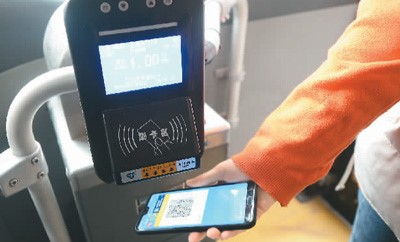


A citizen uses a self-checkout machine in a Walmart supermarket on Fengtian road, Shapingba district, southwest China's Chongqing municipality. (Photo/People's Daily Online)
The number of mobile payment users in China reached 853 million as of December, 2020, making up 86.5 percent of mobile phone users, according to the 47th China Statistical Report on Internet Development released by the China Internet Network Information Center on Feb.3
Paying by scanning a QR code has become a commonplace practice in China. Thanks to this digital revolution, people can purchase almost any type of goods or services using their phones.
Mr. Zhang, who runs a breakfast business in Chaoyang district in Beijing, said that almost all his clients use either the WeChat or Alipay mobile payment systems. He added that compared to traditional payment, mobile payment freed him from the time-consuming task of finding change for his customers. It not only saves time, but is also much more hygienic than handling cash.
Mr Chen, a post-90s person who works in Changping district of Beijing, explained that he has been using mobile payments for a long time, adding that he thinks it’s great he sometimes receives digital coupons while making mobile payments. What impressed him the most is that he and his friends can “go Dutch” more easily when they pay with their mobile wallets.

A passenger scans a QR code to pay for a bus ticket. (Photo/Zhang Tao)
According to a report released by China UnionPay, last year, 98 percent of those surveyed listed mobile payments as their most commonly used way of paying. Experts say that this evolution in methods of payment is an epitome of economic and social development, adding that more services resulting from mobile payments will be sure to usher in an intelligent future.
To better regulate mobile payments, Huang Zhen, dean of the China Internet finance innovation research institute, called for a more comprehensive supervision system that features synergy of multiple supervision departments.
The expert also stressed that more efforts should be made to help the elderly better enjoy these services, such as developing applications that are easy for them to use, and sharing the relevant knowledge with them.
 Fire brigade in Shanghai holds group wedding
Fire brigade in Shanghai holds group wedding Tourists enjoy ice sculptures in Datan Town, north China
Tourists enjoy ice sculptures in Datan Town, north China Sunset scenery of Dayan Pagoda in Xi'an
Sunset scenery of Dayan Pagoda in Xi'an Tourists have fun at scenic spot in Nanlong Town, NW China
Tourists have fun at scenic spot in Nanlong Town, NW China Harbin attracts tourists by making best use of ice in winter
Harbin attracts tourists by making best use of ice in winter In pics: FIS Alpine Ski Women's World Cup Slalom
In pics: FIS Alpine Ski Women's World Cup Slalom Black-necked cranes rest at reservoir in Lhunzhub County, Lhasa
Black-necked cranes rest at reservoir in Lhunzhub County, Lhasa China's FAST telescope will be available to foreign scientists in April
China's FAST telescope will be available to foreign scientists in April "She power" plays indispensable role in poverty alleviation
"She power" plays indispensable role in poverty alleviation Top 10 world news events of People's Daily in 2020
Top 10 world news events of People's Daily in 2020 Top 10 China news events of People's Daily in 2020
Top 10 China news events of People's Daily in 2020 Top 10 media buzzwords of 2020
Top 10 media buzzwords of 2020 Year-ender:10 major tourism stories of 2020
Year-ender:10 major tourism stories of 2020 No interference in Venezuelan issues
No interference in Venezuelan issues
 Biz prepares for trade spat
Biz prepares for trade spat
 Broadcasting Continent
Broadcasting Continent Australia wins Chinese CEOs as US loses
Australia wins Chinese CEOs as US loses